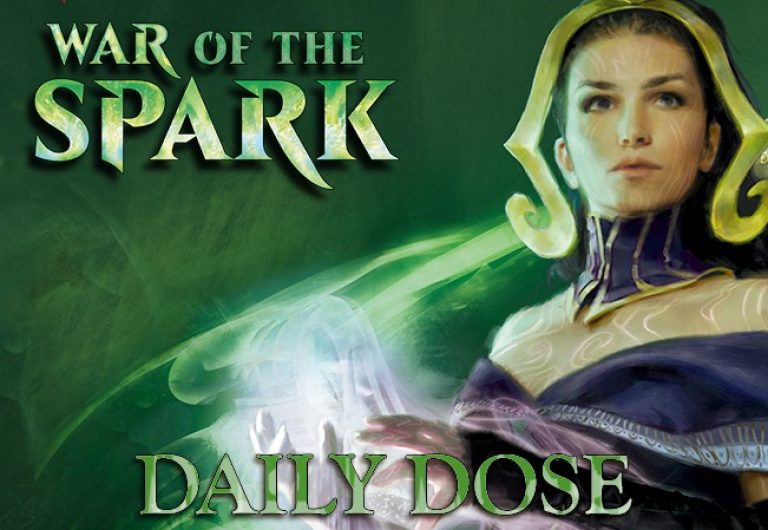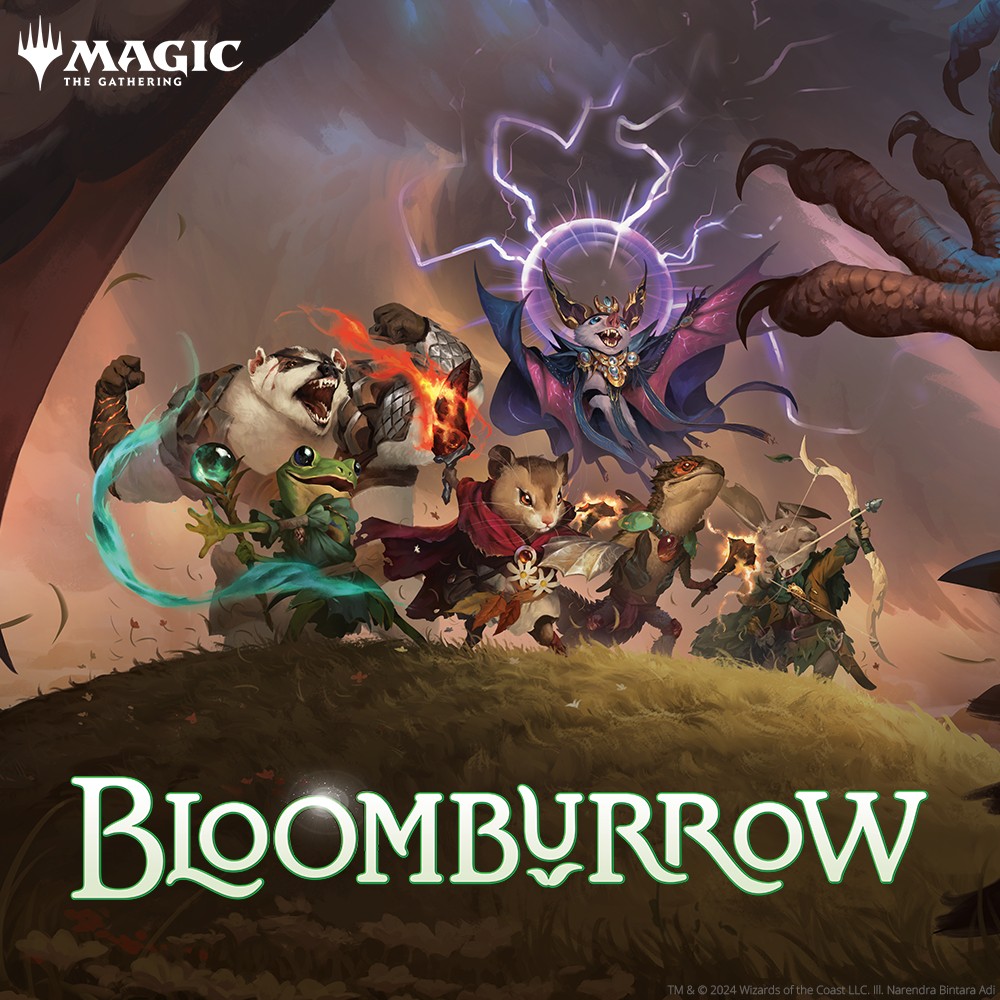Welcome all to the Daily Dose of War of the Spark where today I’m going to talk about the Gods of War of the Spark.
These five Gods are ready to rule Ravnica and each of them has a similar ability:
“When dies or is put into exile from the battlefield, you may put it into its owner’s library third from the top.”
This means the only way to remove these gods is by countering them or making their owner discard it from their hand. The latter will be a little difficult as most often they will be casting the God the turn they draw it from their library.
Each God also has a strong ability when it’s on the battlefield that can take over a game. They all have strong power and toughness with a keyword ability to boot. Will these Gods be as powerful as ones we have seen in previous sets? Only time will tell if these Gods will make an impact, but I believe they will. Let’s break down the five new Gods from War of the Spark.
I want to start off by talking about the return of the White God Oketra. Here is God-Eternal Oketra.
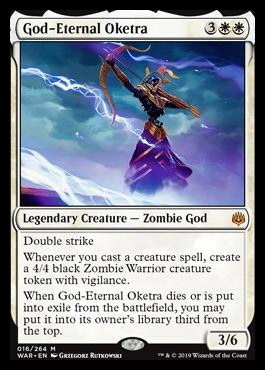
Right from the start, you get a 3/6 creature with double strike. At first glance those might seem like the worst stats out of all the gods, but it's truly a 6/6 creature with any pump spells used on it being doubled thanks to double strike. In addition, Oketra's sure to be a lightning rod for any possible removal (even if it is temporary) since it's atoken creating machine!
While on the battlefield, it allows you to make any creature you cast be greatly more valuable since you get a 4/4 creature with vigilance on top of whatever you cast. I could be wrong, but that seems like a crazy ability. Let me cast this two-drop 2/2 and put an extra 4 power on the battlefield. Look for this God to see some Standard play in the coming months.
Next up is the blue god with the cheapest mana cost of the five. Let's take a look at God-Eternal Kefnet:
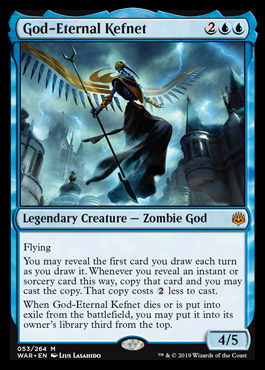
The only god in the set to cost four mana, this makes it a huge advantage over the others. It has the smallest stats, being a 4/5, but the best evasion keyword in flying. No other creature currently in Standard has those stats for a flying creature at four mana except for Demon of Catastrophes.
The first key thing to this card is that you may reveal instead of you having to always reveal your top card. That means you don't have to reveal a card like Absorb and prevent your opponent from knowing that's what you've drawn for the turn. If you do choose to reveal it, you get the chance to cast a copy for two less mana, and keep the card as well. This ability also doubles the impact of any burn spell or card draw spell. Imagine playing a Light up the Stage for one mana, attacking with God-Eternal Kefnet and casting the actual spell for a total look at four extra cards - all for two mana. Not bad at all.
This next god has the possibility of granting you some serious card advantage, but at a cost. Here is God-Eternal Bontu:
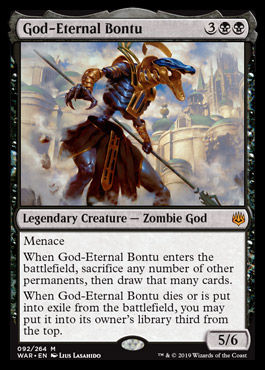
When I look at God-Eternal Bontu, I am immediately reminded the ability on Vraska, Golgari Queen where you can sacrifice a permanent to draw a card and gain a life. I’ve played that card quite a bit and I ask myself, "how often do I usually sacrifice one permanent with this ability to draw a card?" The answer is about 50% of the time, if not less. Looking at God-Eternal Bontu, I then ask myself if I want to be sacrificing multiple permanents to draw multiple cards.
If you are casting God-Eternal Bontu on turn five, unless you have some small creatures you don’t need anymore that you’ve already cast, you might not sacrifice anything. With only five lands, you'll want to keep all of them on the battlefield unless you’ve already got a few in your hand. One thing that will work well with this new ability though is the new Amass mechanic. Being able to sacrifice a 1/1 or 2/2 token to draw a card will often be worthwhile. The good news is that you still get a solid 5/6 body with menace to attack with, even if you don’t end up drawing any cards.
You might notice something a little bit different about the red God in the set. It's time for a closer look at Ilharg, the Raze-Boar:
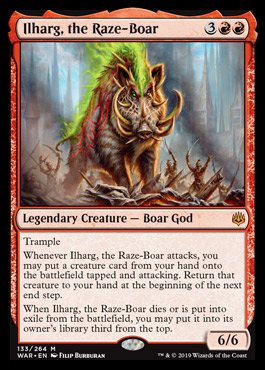
That’s right, it’s a Boar God! It has an ability like that of Champion of Rhonas, except that the extra creature comes in attacking for some sweet extra damage. The downside is that you won’t be able to cast that creature during your second main phase, and it will return to your hand during your end step. So, the good news is that you can give any creature pseudo-haste. But how often will you have meaningful creatures in your hand on turn seven or later?
The best way to gain some value here would be with a creature in your hand that has a great “enters the battlefield” ability on them. A couple good choices would be Demanding Dragon, Ravager Wurm, or Siege-Gang Commander. To top it off, Ilharg comes with a solid 6/6 body with trample to guarantee some damage when you start attacking your opponent.
Finally, we have reached the Green God with the chance to help you win the game on the spot. Last but not least, it's God-Eternal Rhonas:
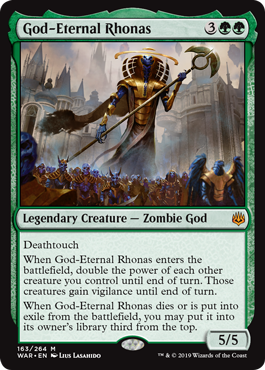
Talk about a way that you can end the game quickly. I'm currently playing a Simic deck with creatures like Pelt Collector, Kraul Harpooner, Steel-Leaf Champion, and Ghalta, Primal Hunger. Just imagine doubling the power of all those creatures and swinging in for an attack. If doubling their power wasn’t enough, whatever survives combat will still be around thanks to the vigilance ability they all get until the end of the turn. You won’t even mind if God-Eternal Rhonas dies as you can count down the turns until you can cast it again! And if God-Eternal Rhonas sticks around, you're left with a solid 5/5 creature with deathtouch, which is tough to block even with multiple creatures.
There you have it; the five gods have been brought to Ravnica and we are the victors as we get to play with them for the next couple of years in Standard. Thanks again for reading the Daily Dose of War of the Spark. Join me again tomorrow as the last week of new preview cards continue.

